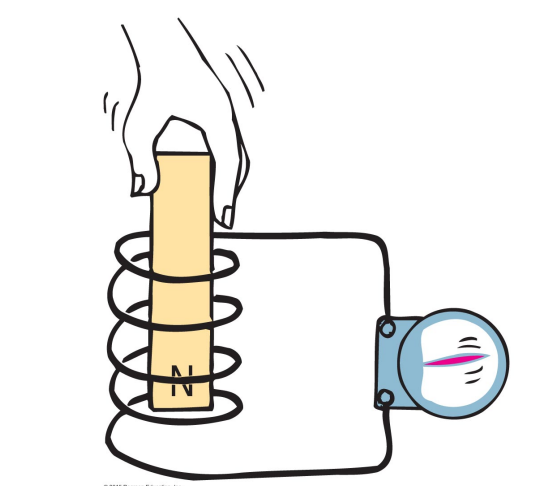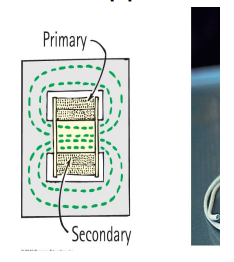PY 131 Chapter 25: Electromagnetic Induction
Magnetic Induction
Independently Faraday and Henry discovered that a changing magnetic field through a loop of wire induced a voltage.

They found:
- the faster the magnet enters the solenoid the larger the voltage,
- the more loops in the solenoid the larger the voltage.
- the voltage was reversed when the magnet was removed
It doesn’t matter whether the magnet moves and the wire stays still, or vice versa, it is the relative motion which matters.
It is not even necessary to introduce or remove the magnet, simply rotating a loop of wire in a magnetic field will induce a voltage in the wire.

The loop doesn’t even have to be a long thin wire, it can be any closed path in a conductor
Due to the induced voltage, a current flows.
The magnetic field created by the current opposes the change in the field which induces the current.
- if you try to insert a magnet into a loop of wire the current flows so as to
repel the magnet. - if you try to remove a magnet from the middle of a loop of wire the current flows so as to attract the magnet
- if you try to insert a magnet into a loop of wire the current flows so as to
In both cases you do work on the magnet and this energy is transferred to the electrons in the wire to raise their electric potential energy.
The electrons will then flow to a place with lower potential.
EXAMPLE 1:
A magnetized iron ball dropped through a copper pipe takes considerably long to fall than an unmagnetized iron ball of the same size dropped through the same pipe. Why? https://youtu.be/N7tIi71-AjA
When a magnetized iron ball is dropped through a copper pipe, it induces eddy currents in the copper that create an opposing magnetic field, resulting in a drag force that slows down the ball's fall. The unmagnetized iron ball does not create these eddy currents and hence does not experience the same drag force, allowing it to fall faster.
The magnetic field which induces the current in the wire does not have to come from a magnet, it can be from a current in a different circuit.
If a second loop is moved (or rotated) relative to the circuit producing the magnetic field, a voltage is induced in the second loop.
Another way to change the magnetic field is to the change the current in the first circuit so even with no relative motion, a voltage will be induced in a second circuit.
Generators
- Generators are machines for converting mechanical energy into electrical energy.
- if the current from the generator is dc the generator is often called a dynamo, if the current is ac the generator is called an alternator
- All generators have two parts – one that moves called the rotor, and one that stays still called the stator.
- Generators are essentially motors in reverse.
- Rather than electrical energy in, motion out, for a generator it is motion in, electrical energy out.

- Generators are found in power stations where the mechanical energy is the rotation of a loop or wire attached to a turbine which rotates due to pressure forces from a fluid.
- Diesel generators are similar but the loop or wire is attached to the camshaft of an diesel engine.
- Some bikes have dynamos to generate the electricity to power the lights
Transformers
Transformers also operate according to the same principle.
A transformer contains two solenoids from separate circuits.
The two solenoids have different numbers of loops.
An alternating current in one solenoid (the primary) generates a magnetic field which changes with time.
A alternating voltage (and an ac) is induced in the second solenoid (the secondary) due to the changing magnetic field.

In practice the secondary solenoid is entirely within the primary solenoid and both are wrapped around an iron core.

Transformers come into two types: step up and step down.
- In a step up transformer the secondary has more coils than the primary
and the voltage in the secondary is higher - In a step down the secondary has fewer coils than the primary and the voltage in the secondary is smaller.
- In a step up transformer the secondary has more coils than the primary
The voltage changes so that
- Primary Voltage / Loops in Primary Coil = Secondary Voltage / Loops in Secondary Coil
==The power in each coil is the same.==
Since the power is
- Power = Current x Voltage
an increase of voltage in the secondary must be compensated by a decrease in the current in the secondary
The amount of Joule heating is given by
- Power Lost: (Current)^2 x Resistance
so a decrease in the current leads to less heating and less electrical energy loss.
It is the ability to transform voltages and currents which makes ac so useful for long distance transmission.
The voltage generated at a power station is stepped up for transmission along overhead lines.
On the edge of the city there are distribution substations where the voltage is stepped down for transmission through underground cables and/or secondary overhead transmission lines.
Close to the point of use the voltage is stepped down again at distribution substations.
EXAMPLE 1:
The adapter for a laptop is a combination of a transformer and a bridge rectifier. The transformer in an adapter needs to step down the voltage from 120V to 24V. If the primary coil has 100 turns, how many turns does the secondary have? If the output current is 1.8 A, what is the input current?
- The voltage is stepped down from 120V to 24V, which is a 5:1 ratio. Since the transformer equation is V1/V2 = N1/N2, we can solve for N2:
- 120V / 24V = 5 = N1/N2
- N2 = N1/5 = 100/5 = ==20 turns==
- To find the input current, we use the equation:
- input current = output current x (output voltage / input voltage)
- Plugging in the values, we get:
- input current = 1.8 A x (24 V / 120 V) = ==0.36 A==
EXAMPLE 2:
Why does the current through a transformer need to be ac? Why can’t you step up or down a dc?
- A transformer works on the principle of electromagnetic induction, which requires a changing magnetic field to induce a voltage in a coil. Alternating current (AC) produces a changing magnetic field, whereas direct current (DC) does not, so a transformer can only be used to step up or down an AC voltage.
Displacement Current
- Faraday’s Law is that a changing magnetic field produces an electric field.
- Later Maxwell reasoned that the opposite is also true: a changing electric field produces a magnetic field.
- Since it was already known that magnetic fields could be produced by currents, Maxwell called the rate of change of an electric field the displacement current.
- although this is the name, there are no moving charges in a displacement current.
- The displacement current completes a symmetry between the magnetic and electric fields – a change of either one in time produces the other.
EXAMPLE 1:
An uncharged capacitor has no electric field between its plates. A charged capacitor does have a field. If a magnetic compass is placed between the plates of a capacitor while it is charging, will the needle of the compass be deflected?
- ==Yes.==
- A displacement current generates a magnetic field just like a regular current.